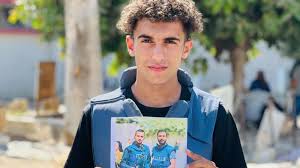The ongoing conflict in Gaza has claimed yet another victim from the ranks of media professionals. Hassan Hamad, a 19-year-old Palestinian journalist, was killed in an Israeli air strike on his home in the Jabalia refugee camp in northern Gaza. This tragic incident occurred just days after Hamad reportedly received threats warning him to cease his journalistic activities in the region. The death of this young Palestinian journalist has once again brought into sharp focus the perilous conditions under which media workers operate in conflict zones, particularly in Gaza, where the toll on journalists has been staggering.
The Escalating Toll on Media Workers in Gaza
Since the outbreak of the current conflict in October 2023, the number of journalists and media workers killed in Gaza has reached alarming proportions. According to Gaza’s Government Media Office, Hamad’s death brings the total number of Palestinian journalists killed to 175. The Committee to Protect Journalists (CPJ) reports a slightly lower but still devastating figure of at least 128 journalists and media workers among the more than 41,000 people killed in the conflict. These numbers underscore the extreme danger faced by those attempting to report on the ongoing war, raising serious questions about the protection of press freedom and the safety of journalists in conflict zones.
Threats and Intimidation: A Prelude to Tragedy
In the days leading up to his death, Hamad reportedly received ominous warnings that foreshadowed the tragic turn of events. Colleagues of the young journalist, including Palestinian journalist Maha Hussaini, revealed that Hamad had been threatened by an Israeli officer through WhatsApp messages and phone calls. These communications allegedly ordered Hamad to stop filming in Gaza, with one message chillingly warning, “Listen, if you continue spreading lies about Israel, we’ll come for you next and turn your family into […] This is your last warning.” The Israeli government has not yet commented on these allegations or on Hamad’s death, leaving many questions unanswered about the circumstances surrounding this incident.
The Life and Work of a Palestinian Journalist
Despite his young age, Hassan Hamad had already established himself as a dedicated journalist, working tirelessly to document the realities of life in Gaza amidst the ongoing conflict. For over a year, Hamad had been freelancing as a TV reporter, with his work appearing on major networks including Al Jazeera. His commitment to his craft was evident in the lengths he would go to ensure his reports reached the outside world. Colleagues describe how Hamad would spend hours on rooftops searching for an internet signal strong enough to transmit his videos, risking his safety to provide timely and accurate coverage of events on the ground.
Hamad’s dedication to his work came at a great personal cost. In an effort to protect his family from potential targeting, he had chosen to live apart from them. This sacrifice highlights the difficult choices journalists in conflict zones often face, balancing their professional responsibilities with concerns for their own safety and that of their loved ones. The morning of his death, Hamad had made a final call to a colleague to send his last video, a poignant reminder of his unwavering commitment to his profession until the very end.
The Impact on Press Freedom and Truth-Telling
The death of Hassan Hamad and the numerous other journalists killed in Gaza raises serious concerns about the state of press freedom in conflict zones and the ability of the media to report accurately on events in these areas. Carlos Martinez de la Serna, Program Director at the Committee to Protect Journalists, emphasized the far-reaching consequences of these losses, stating, “Every time a journalist is killed, injured, arrested, or forced to go to exile, we lose fragments of the truth.” This statement underscores the crucial role that journalists play in providing the world with accurate information about conflicts and the devastating impact their loss has on our collective understanding of these events.
The targeting of journalists, whether deliberate or as collateral damage in military operations, not only violates international law but also serves to obscure the realities of conflict from the global public. The chilling effect of such incidents can lead to self-censorship among surviving journalists and media outlets, further limiting the flow of information from conflict zones. As the death toll among media workers in Gaza continues to rise, there are growing calls for increased protection for journalists and for those responsible for these casualties to be held accountable under international law.
The death of Hassan Hamad, a young and dedicated Palestinian journalist, serves as a stark reminder of the dangers faced by media professionals in conflict zones. His tragic story is but one among many, highlighting the urgent need for better protection of journalists and stronger safeguards for press freedom in areas of conflict. As the international community grapples with the ongoing crisis in Gaza, it is imperative that the safety of journalists and the preservation of their vital role in informing the world be prioritized. Only through ensuring the security of those who risk their lives to bring us the truth can we hope to fully understand and address the complex realities of conflicts like the one in Gaza. The loss of each journalist not only silences an individual voice but also dims our collective understanding of the world’s most pressing crises.
















